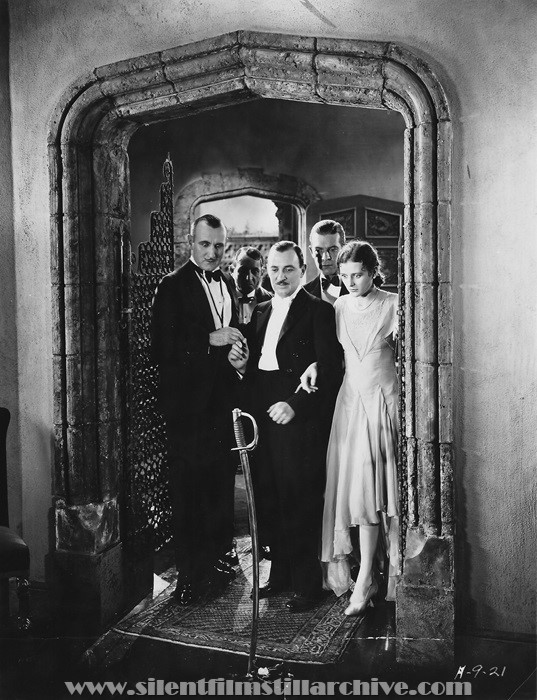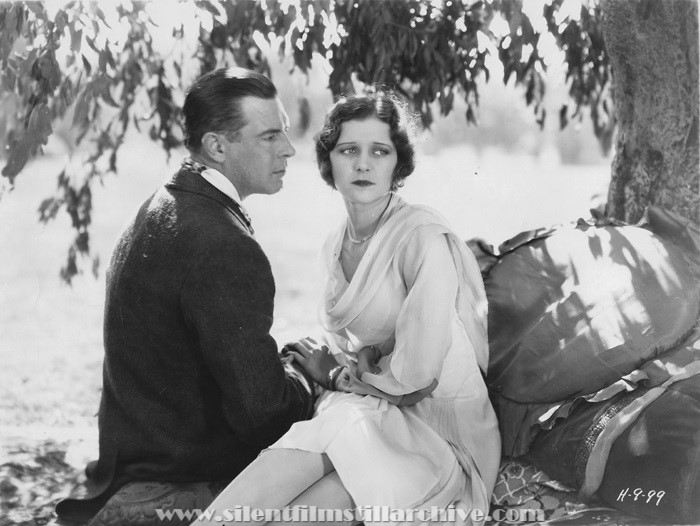![]()

Trent's Last Case (1929)

H-9-21 Donald Crisp, Raymond Hatton, Raymond Griffith, Lawrence Gray, and Marceline Day

H-9-25 Lawrence Gray, Raymond Griffith, and Marceline Day

H-9-64 Marceline Day and Raymond Griffith

H-9-89 Raymond Hatton and Donald Crisp

H-9-90 Raymond Hatton and Donald Crisp

H-9-98 Raymond Hatton, Raymond Griffith, and Edgar Kennedy

H-9-99 Lawrence Gray and Marceline Day
"Trent's Last Case"
with Raymond Griffith, Marceline
Day, Raymond Hatton
(Synchronized)
Fox Synch. Length: 5834 ft.
Silent 5809 ft.
MISSES PLENTY WITH INCONSISTENT PLOT AND UNCONVINCING ATMOSPHERE. LACKS SOUND EFFECTS THAT MYSTERY STORY NEEDS.
Murder mystery, adapted from story by E. C. Centley. The setting is an old English baronial hall, with an old Scotch character wearing a plaid scarf., English butler and maid and a lot of New York cops coming in at the climax to effectually gum up the atmosphere. Added to this inconsistency is a far greater one of Raymond Griffith, the comedian, case as the criminal investigator, breezing in like the comedian he is and treating the serious crime situation like a musical comedy plot. Right there the offering is sunk as far as imressing any intelligent audience. It may have been in the story, but that makes it all the worse. Also it is developed witah an anti-climax. The punch scene of what really happened is the mysterious death is told by the detective in pantomime and titles and it falls flat.
Cast: Raymond Griffith, Raymond Hatton, Marceline Day, Donald Crisp, Lawrence Gray, Nicholas Soussanin, Anita Garvin, Ed Kennedy.
Director, Howard Hawks; Author, E. C. Bentley; Adaptor, Beulah Marie Dix; Scenarist, Scott Darling; Editor, Not listed; Titler, Malcolm S. Boylan; Cameraman, Harold Rosson.
-- Film Daily, June 2, 1929, p. 8
TRENT'S LAST CASE: Fox mystery melodrama from the story by E. C. Bentley with Raymond Griffith, Raymond Hatton, Marceline Day, Donald Crisp, Lawrence Gray, Nicholas Soussanin, Anita Gravin (sic) and Ed Kennedy. Directed by Howard Hawk (sic). Relased March 31. Length -----
TYPE AND THEME: Evelyn Manderson, young wife of the wealthy Manderson,
realizes her mistake in marrying but is resolved to go through with it.
Jack Marlowe, Manderson's secretary, is in love with Evelyn but, despite
his pleadings, Evelyn refuses to be unfaithful. Manderson, understanding
what is going on, plans revenge on Jack. He gives Jack a bag of money to
deliver and then plans to shoot himself, to give the impression that
Jack tried to escape after shooting him. At a hearing after
Manderson's death, strange things take place. The picture moves swiftly
with thrilling happenings.
-- Exhibitor's Herald-World, May 18, 1929, p. 65
Trent's Last Case
Average Program Rating
(Reviewed by Don Ashbaugh)
(Silent)
"TRENT'S LAST CASE" takes slight portions from half a dozen other film thrillers of past picture history. It is very slow and draggy for the first four reels, but concludes with a novel and whirlwind denouement in the final two reels.
Once Raymond Griffith, as the amateur detective, takes charge, the action becomes swift and the humor evident. Before his appearance, the picture shapes as just another murder mystery without much interest. Griffith is just himself -- debonair, subtle and amusing.
At the outset, it is well established that everyone hates Sigsbee Manderson, the villain with a club foot. The future suspects are lined up; Manderson's wife, his secretary who is secretly in love with the wife, the wife's uncle, the butler, and the maid. The detective arrives on the scene before the murder occurs, this being Manderson's own quaint conceit.
Presently Manderson is murdered, and the stupid police detective is brought in to be finally shown the truth by the amateur detective. Griffith gets plenty of laughs with a piano playing sequence while the detective is quizzing the suspects.
Circumstances point to the secretary as the murderer; and he is thoroughly grilled. Griffith uncovers the fact that Manderson is reality killed himself, first arranging matters so that suspicion would point to his wife's lover as the murderer.
Neither the story nor direction is outstanding -- Raymond Griffith walks off with acting honors, but is surrounded by an excellent cast of players.
Drawing Power: Rates as a program attraction for tri-weekly or daily change houses. Not of sufficient strength to carry as a week run, except with supporting bill of vaudeville
Produced and released by Fox. Story by E. C. Bentley. Scenario by Beulah Marie Dix. Directed by Howard Hawks. Photographed by Harold Rosson Titles by Malcolm Stuart Boylan. Released: March 31, 1929. Length: 5,809 feet.
THE CAST
| Phillip Trent | Raymond Griffith |
| Josuah Cupples | Raymond Hatton |
| Evelyn Manderson | Marceline Day |
| Jack Marlowe | Lawrence Gray |
| Martin | Nicholas sousanin |
| Sigsbee Manderson | Donald Crisp |
| Ottillie Dunois | Anita Garvin |
| Inspector Murch | Ed Kennedy |
-- Motion Picture News, June 8, 1929, p. 1969
with Raymond Griffith, Marceline Day, Raymond Hatton, and Donald Crisp. Directed by Howard Hawks. Fox.
More Information on this film...
Books
(none)
Last Modified August 14, 2024



















